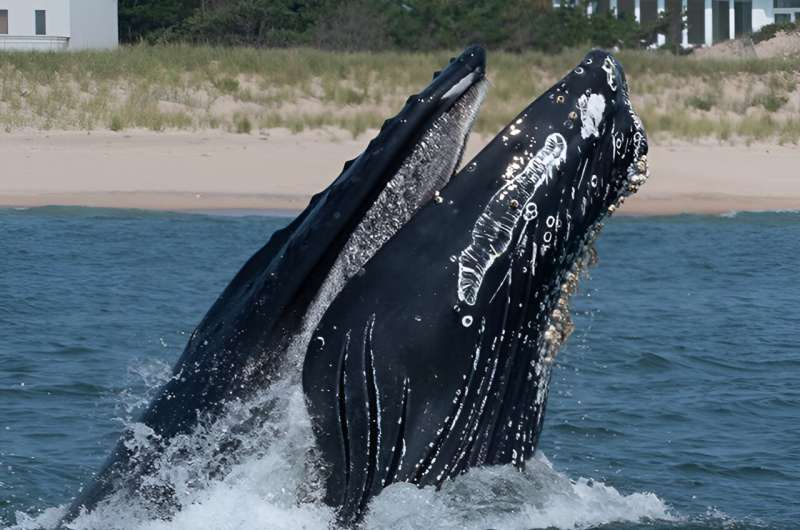This article has been reviewed according to Science X's editorial process and policies. Editors have highlighted the following attributes while ensuring the content's credibility:
fact-checked
peer-reviewed publication
trusted source
proofread
Vessel strikes drive large whale strandings

Increased whale strandings on the east coast of the United States remain a concern for biologists and citizens alike. Why this increase has occurred over a number of years is still being debated.
But a new analysis of long-term data collected on the location, date and timing of strandings reveals that vessel strikes—exacerbated by increased vessel traffic in whale foraging areas used by juvenile humpback whales—is a major driver of these strandings.
Details of the analysis are in a paper published in Conservation Biology.
By the early 1900s, populations of many large whales were devastated by commercial whaling. Today large whales are still affected by multiple stressors caused by humans. These include pollution, entanglement in fishing gear, disturbances such loud noises in the water, vessel strikes and other activities generated by people. These activities can lead to injuries and deaths as illustrated by strandings of whales.
Led by Lesley Thorne, Ph.D., this study investigated whale strandings and used data collected by the U.S. Marine Mammal Health and Stranding Response Program, along with information collected on mortality and serious injury (MSI) determinations for humpback whales on the U.S. east coast. More than 200 strandings of humpback whales occurred from 2016 through 2022, and around 500 strandings occurred in total going back to 1995.
Thorne and co-author Dave Wiley, Ph.D., assessed spatial and temporal patterns of strandings relative to patterns of potential threats to large whales such as vessel traffic, entanglement in fishing gear, and offshore wind development. While they looked at strandings of all large whales, the detailed analysis focused on humpbacks since these whales dominate the strandings data.
Contrary to unsubstantiated claims, the authors found no evidence that offshore wind development along the Northeast coast played a role in any observed patterns of strandings and in MSI determinations in humpback whales.
"Very little offshore wind energy development occurred over the study period, yet we examined potential threats from offshore wind in different phases of development," says Thorne. "We focused more on offshore wind site assessment and characterization to match the phase that predominantly occurred during the period. And our spatiotemporal assessment did not suggest a link between strandings and site assessment and characterization surveys for offshore wind farms."
The researchers report that the New York and Virginia coastlines are hotspots of whale strandings. The data revealed high vessel traffic in these regions, which increased markedly during the period of unusual whale deaths and strandings.
Thorne explains that humpback whales began regularly using the summer foraging habitat in New York waters around 2011. Humpback whales feeding in New York and Virginia are predominantly juvenile whales which feed in nearshore waters in these states. The researchers suggest that increased vessel traffic in these regions, combined with foraging activities, and inexperience of juvenile humpbacks, create a setting that makes these whales more vulnerable to vessels striking and injuring them.
The authors also write that "in addition to increases in vessel traffic, changes to humpback whale habitat use may play a role in the observed increases in stranding and mortality and serious injuries."
Although increased vessel traffic causing whale strikes appears to be a driver of continual whale standings on the east coast, Thorne and Wiley caution that their paper outlines important gaps in knowledge that need to be addressed to better understand the causes of whale standings.
They outline three key steps for future research:
"First, a more thorough understanding of the movements and habitat use of humpback and other large whales, both spatially and seasonally, is needed to better understand and predict threats to these species.
"Second, assessments of broad spatiotemporal changes to the abundance and distribution of prey species that might influence large whale distribution are needed to understand both the habitat use and health of large whales.
"Third, more work is needed to determine how habitat use and foraging behavior (e.g., surface feeding and feeding in shallow coastal habitats) might affect the risk of vessel strike."
More information: L. H. Thorne et al, Evaluating drivers of recent large whale strandings on the East Coast of the United States, Conservation Biology (2024). DOI: 10.1111/cobi.14302
Journal information: Conservation Biology
Provided by Stony Brook University





















